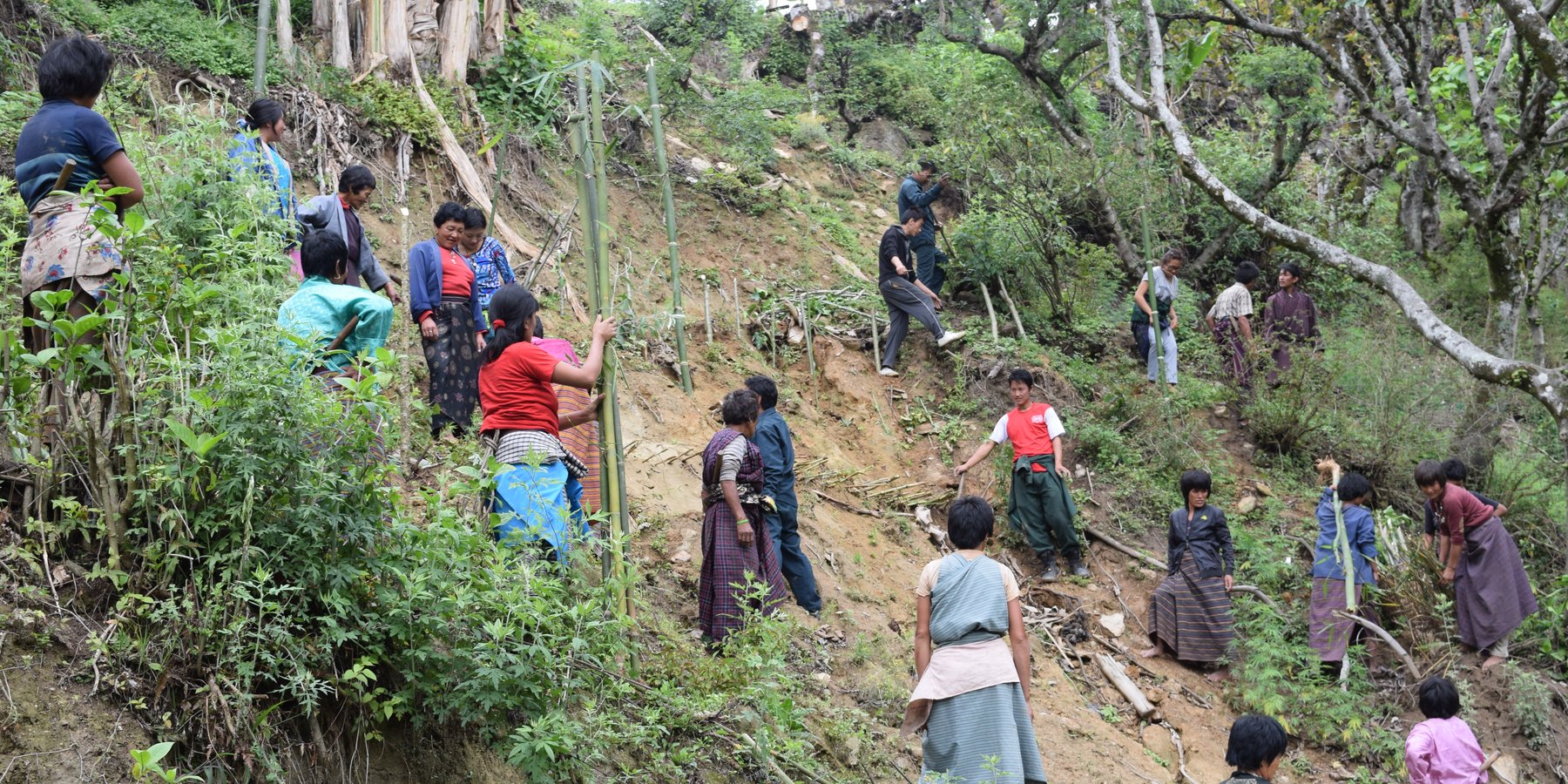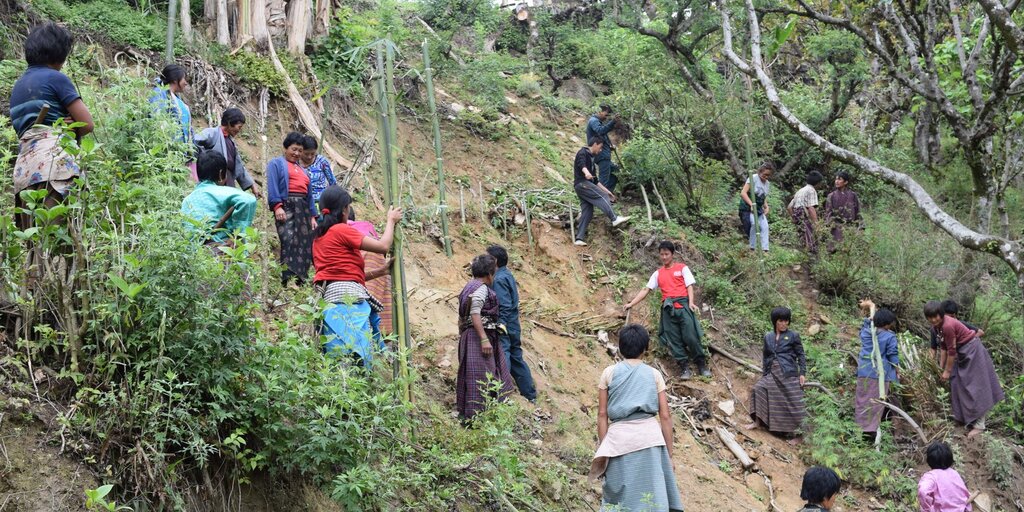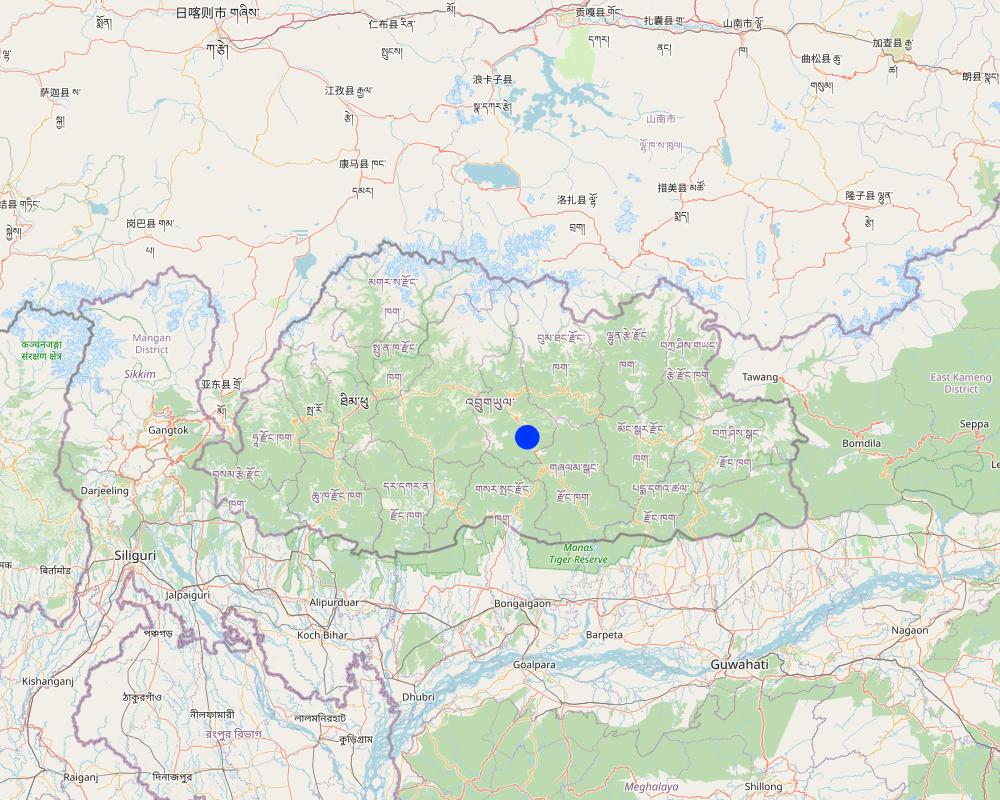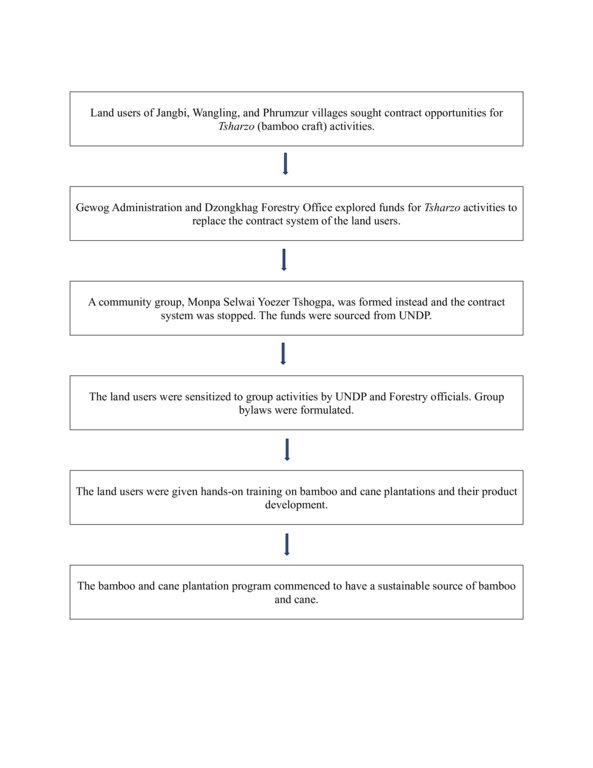Community Forest Management Group [Bhutan]
- Creation:
- Update:
- Compiler: Tshering Yangzom
- Editor: Haka Drukpa
- Reviewers: William Critchley, Rima Mekdaschi Studer, Joana Eichenberger
Drongdhey Nagtshel Zinchong Dhetshen (གྲོང་སྡེ་ནགས་ཚལ་འཛིན་སྐྱོང་སྡེ་ཚན།)
approaches_6861 - Bhutan
View sections
Expand all Collapse all1. General information
1.2 Contact details of resource persons and institutions involved in the assessment and documentation of the Approach
Key resource person(s)
land user:
Sonam
NA
Jangbi Chiwog, Langthel Gewog, Trongsa Dzongkhag
Bhutan
land user:
Nagari
NA
Jangbi Chiwog, Langthel Gewog, Trongsa Dzongkhag
Bhutan
land user:
Chencho
NA
Jangbi Chiwog, Langthel Gewog, Trongsa Dzongkhag
Bhutan
land user:
Lethro
17750390
NA
Jangbi Chiwog, Langthel Gewog, Trongsa Dzongkhag
Bhutan
Name of project which facilitated the documentation/ evaluation of the Approach (if relevant)
Strengthening national-level institutional and professional capacities of country Parties towards enhanced UNCCD monitoring and reporting – GEF 7 EA Umbrella II (GEF 7 UNCCD Enabling Activities_Umbrella II)Name of the institution(s) which facilitated the documentation/ evaluation of the Approach (if relevant)
National Soil Services Center, Department of Agric (National Soil Services Center, Department of Agric) - Bhutan1.3 Conditions regarding the use of data documented through WOCAT
When were the data compiled (in the field)?
16/07/2023
The compiler and key resource person(s) accept the conditions regarding the use of data documented through WOCAT:
Ja
1.4 Reference(s) to Questionnaire(s) on SLM Technologies
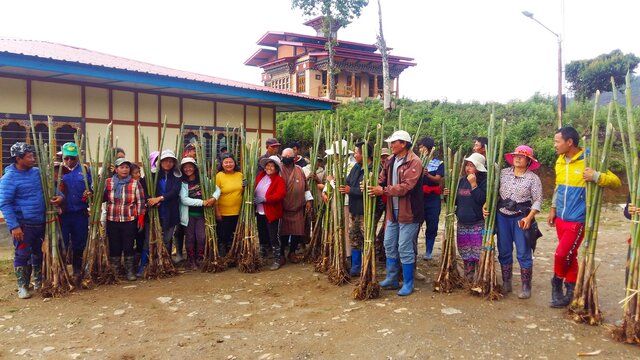
Cane and Bamboo Plantation to Sustain Raw Materials [Bhutan]
Cane and bamboo plantations are managed by land users and indigenous communities to sustain these valuable raw materials for making handicraft items. Tsharzo (bamboo craft), is one of the main sources of income for land users. Tsharzo makes use of cane and bamboo to weave products such as backpacks, baskets …
- Compiler: Tshering Yangzom
2. Description of the SLM Approach
2.1 Short description of the Approach
The Community Forest Management Group (CFMG) functions with an aim to sustainably manage and utilize potential Non-Wood Forest Products (NWFP) such as cane and bamboo to diversify income sources. The Jangbi CFMG comprises three Monpa (indigenous) communities viz. Jangbi, Wangling and Phrumzur. The group's main mandates are to maintain raw material (bamboo and cane) germplasm, uphold the ancestral arts and crafts skills, and ensure the sustainable harvest of natural raw materials.
2.2 Detailed description of the Approach
Detailed description of the Approach:
Tsharzo (bamboo craft) is popular in the eastern and southern parts of Bhutan where raw materials such as bamboo and cane are abundant. Tsharzo makes use of cane and bamboo to weave products such as orongbhazib (backpack), lapchu (hand basket), chungchu (basket), bechab (winnow), tsew (basket to carry fodder, fruits, shoots etc.) and pari (mats), among others. The Community Forest Management Group (CFMG) under Jangbi chiwog, Trongsa Dzongkhag is called Monpa Selwai Yoezer Tshogpa. The Jangbi CFMG is one of the successful groups that promote bamboo and cane products in the country. The group consists of 59 households (HH) from three villages, Jangbi (23 HH), Wangling (22 HH), and Phrumzur (14 HH). The group was formed under the United Nations Development Programme (UNDP) on 14 April 2000, and officially came into play in 2007, upon drafting the bylaws. The bylaws were revised upon the need for further improvement in the year 2018. The group was formed to promote and enhance bamboo and cane products, thereby sustaining the existing trend and culture of the community. The group's main mandates are to maintain raw material germplasm (namely bamboo and cane), uphold ancestral arts and crafts skills, and ensure the sustainable harvest of natural raw materials.
The group received initial fund support of Nu. 1,400,000 from UNDP and Nu. 800,000 from Bhutan Orchids, a non-governmental organization (NGO). The government has given a total of 45 acres of land to the land users of Jangbi CFMG to plant bamboo and cane. Out of the 45 acres, 15 acres of land are collectively managed by all the land users of Jangbi CFMG for nursery raising. And 10 acres each is managed by each village under Jangbi chiwog for plantation activities. The land users plant different varieties of bamboo on the land. Some major activities carried out by the group involve documentation of the existing stock of cane and bamboo and new plantations. Cane and bamboo plantations are fenced to protect against wild and domestic animals.
Initially, Tsharzo in Jangbi CFMG was taken up on a contract basis. However, the proposal to establish a community Tsharzo group named Monpa Selwai Yoezer Tshogpa was approved by the Dzongkhag administration and was funded by the UNDP. Upon approval of the proposal, the Dzongkhag Forestry Department assisted the land users in land development (nursery development) for the cultivation of bamboo and cane in the allocated areas on 45 acres of state-owned land. The stakeholders involved in the formation of CFMG were the community members of Jangbi, Wangling, and Phumzur villages, of Jangbi chiwog, an NGO (Bhutan Orchids), the gewog administration, the forestry department, and UNDP. The community members’ roles included carrying out fieldwork (plantation of bamboo and cane, their maintenance) and engaging in decision-making processes under CFMG. The gewog administration supported the group with technical, financial, and advisory services. The NGO provided fund support of Nu. 800,000 and UNDP provided initial fund support of Nu. 1,400,000. The forestry department sourced the initial funds from UNDP, formulated bylaws, and facilitated hands-on training on bamboo and cane plantations.
The benefits of the approach include the establishment of dedicated germplasm, sustainable harvest of natural raw materials, conservation and promotion of ancestral arts and crafts skills, social cohesion through group formation, and employment opportunities. Bamboo and cane plantations play a great role in preventing soil degradation. Bamboo and cane have extensive root systems that help prevent erosion, stabilize soil, and reduce landslide risks. They are excellent for revegetation as they quickly establish themselves. Bamboo is also an efficient carbon sink, absorbing significant amounts of carbon dioxide from the atmosphere. This helps mitigate climate change by reducing greenhouse gas concentrations. Bamboo and cane provide habitats for some organisms thereby increasing biodiversity. Products made from bamboo and cane are biodegradable, reducing the environmental impact.
2.3 Photos of the Approach
2.5 Country/ region/ locations where the Approach has been applied
Country:
Bhutan
Region/ State/ Province:
Jangbi Chiwog, Langthel Gewog, Trongsa Dzongkhag
Map
×2.6 Dates of initiation and termination of the Approach
Indicate year of initiation:
2000
Comments:
The CFMG of Jangbi was initially instituted on 14/4/2000 with 47 member HH. Later in 2007, the group was formalized with the development of by-laws and was further reviewed in 2018 with a total of 49 member HH. The approach is ongoing.
2.7 Type of Approach
- project/ programme based
2.8 Main aims/ objectives of the Approach
The group's main aims are:
i. To maintain raw material germplasm (bamboo and cane).
ii. Uphold the ancestral arts and crafts skills.
iii. To ensure sustainable harvest of natural raw materials.
2.9 Conditions enabling or hindering implementation of the Technology/ Technologies applied under the Approach
social/ cultural/ religious norms and values
- enabling
The bamboo and cane plantation for their products is enabled under the CFMG. The bamboo and cane products are one the major identities, sources of income, and an ancestral legacy. The socio-cultural norms enable the technology implemented under this approach.
availability/ access to financial resources and services
- enabling
The plantation and production of bamboo and cane products are not very financially intensive. Also, the products fetch good market prices.
institutional setting
- enabling
The sale of bamboo and cane products has helped diversify the income sources of the group members and improve their living standards.
collaboration/ coordination of actors
- enabling
The group is being spearheaded by a chairman, a secretary, and a treasurer. These key actors have been vibrant in supervising the functions of the group. Hence, the group's coordination has been beneficial in implementing the technology under this approach.
legal framework (land tenure, land and water use rights)
- enabling
The legal guidelines of the group are clear and convenient with respect to user rights. For instance, the members are provided with 45 acres of state land to use as germplasm (bamboo and cane).
policies
- enabling
The policies framed under this approach are aimed mainly at ensuring the sustainability of the raw materials. For instance, each household is allocated 2 acres of natural forest to collect 2 man loads of bamboo, 2 man loads of cane, and 2 man loads of Bji in a year. They are not allowed to collect any raw materials from the 45-acre germplasm. The respondents think that it is an effective approach to sustaining the raw materials.
land governance (decision-making, implementation and enforcement)
- enabling
The overall land governance is as per the state's land rules and regulations, which is not a hindering factor.
knowledge about SLM, access to technical support
- enabling
With the awareness of SLM, the group was instituted. The implementation of the technology has not been hindered.
markets (to purchase inputs, sell products) and prices
- enabling
As per the respondents, the market has not been a problem. They are also given opportunities to display and advocate their products in various functions nationwide.
workload, availability of manpower
- enabling
The bamboo and cane product making is not very labour-intensive. Rather it is skill oriented. Hence, manpower/workload is not an issue. The by-laws of the groups clearly mention the roles and responsibilities of the members and their involvement in any activities related to cane and bamboo management is mandatory.
3. Participation and roles of stakeholders involved
3.1 Stakeholders involved in the Approach and their roles
- local land users/ local communities
The community members of Jangbi, Wangling, and Phrumzur villages.
Their roles include carrying out fieldwork (plantation of bamboo and cane, their maintenance) and engaging in decision-making processes under CFMG.
- NGO
Bhutan Orchids
Provided additional fund support of Nu. 800,000.
- local government
The Gewog Administration
It supports the group with technical, financial, and advisory services.
- national government (planners, decision-makers)
Department of Forests and Park Services (DoFPS)
The initial fund was sourced from UNDP. The Department of Forests and Park Services technically supported the formulation of a management plan and by-laws for the group and facilitated hands-on training on bamboo and cane plantations.
- international organization
UNDP
UNDP provided initial fund support of Nu. 1,400,000.
3.2 Involvement of local land users/ local communities in the different phases of the Approach
| Involvement of local land users/ local communities | Specify who was involved and describe activities | |
|---|---|---|
| initiation/ motivation | interactive | In the year 2000, a few community representatives approached the Forestry officials to explore the market and sale plans for bamboo and cane products. The representatives expressed an interest in acting as vendors. In return, the forestry officials suggested instituting a group. Hence, the idea of Community Forest Management Group (CFMG) was conceived for managing cane and bamboo species (non-wood forest produce). |
| planning | passive | The fund securing was supported by Gewog Administration whereas formulation of a management plan and by-laws was technically supported by forestry officials, Department of Forests and Park Services. |
| implementation | interactive | Following the sensitization program from UNDP and the Gewog Administration, a hands-on training program was conducted by forestry officials on bamboo and cane plantations. |
| monitoring/ evaluation | self-mobilization | The monitoring activities are carried out by the group members themselves on an annual basis. As such, the scale-up programs are limited due to budget constraints. |
3.3 Flow chart (if available)
Description:
This is a flow chart of Monpa Selwai Yoezer tshokpa (Jangbi Tsharzo)
Author:
Tenzin chophel
3.4 Decision-making on the selection of SLM Technology/ Technologies
Specify who decided on the selection of the Technology/ Technologies to be implemented:
- land users alone (self-initiative)
Explain:
The community expressed their interest in marketing their already existing bamboo and cane products to the erstwhile Forestry Office. Their main objectives were to enhance the livelihoods of the Monpa community through the sale of bamboo and cane products, uphold their ancestor's legacies and traditions, and ensure the sustainability of the raw materials.
Specify on what basis decisions were made:
- personal experience and opinions (undocumented)
4. Technical support, capacity building, and knowledge management
4.1 Capacity building/ training
Was training provided to land users/ other stakeholders?
Ja
Specify who was trained:
- land users
If relevant, specify gender, age, status, ethnicity, etc.
All the group members (both male and female) were trained.
Form of training:
- demonstration areas
- public meetings
Subjects covered:
The members were trained on the plantation and management of bamboo and cane and about their germplasm.
4.2 Advisory service
Do land users have access to an advisory service?
Ja
Specify whether advisory service is provided:
- on land users' fields
- at permanent centres
Describe/ comments:
The CFMG is under the jurisdiction of the Jigme Singye Wangchuck National Park under the Department of Forests and Park Services. The advisory services are provided by the Langthel Park Range Office.
4.3 Institution strengthening (organizational development)
Have institutions been established or strengthened through the Approach?
- yes, greatly
Specify the level(s) at which institutions have been strengthened or established:
- local
Describe institution, roles and responsibilities, members, etc.
The sale of bamboo and cane products has helped diversify the income sources of the group members and improve their living standards.
Specify type of support:
- financial
4.4 Monitoring and evaluation
Is monitoring and evaluation part of the Approach?
Ja
Comments:
The monitoring and evaluation of the management plan is conducted by group members and Department of Forests and Park Services. In order to ensure the proper implementation of activities, annual monitoring is conducted by the executive committee members (Chairman, Secretary and Treasurer) based on the management plan prescriptions and by-laws framed for a period of 10 years. Similarly, the respective field office conducts annual monitoring of the group and submits the report to the Department for review and accordingly advice the field offices to carry out the corrective measures. Based on the Forest and Nature Conservation Act and Rules, a midterm evaluation on the 5th year and final evaluation on the 10th year of the plan period is conducted by the Department of Forests and Park Services for monitoring of the activities planned for 10 years. The monitoring and evaluation report for the group shall determine the revision and implementation of the plan for next 10 years.
If yes, is this documentation intended to be used for monitoring and evaluation?
Nee
4.5 Research
Was research part of the Approach?
Nee
5. Financing and external material support
5.1 Annual budget for the SLM component of the Approach
If precise annual budget is not known, indicate range:
- < 2,000
Comments (e.g. main sources of funding/ major donors):
The total fund supported by UNDP and Bhutan Orchids was Nu. 1,400,000 and Nu. 800,000 respectively. These budgets were granted for both the institution of the group and the initiation of technology implementation. The fund support was for the commencement of bamboo and cane plantations in the initial year. There is no funding now and the land users now manage the plantation activities themselves.
5.2 Financial/ material support provided to land users
Did land users receive financial/ material support for implementing the Technology/ Technologies?
Ja
If yes, specify type(s) of support, conditions, and provider(s):
The total fund of Nu. 2,200,000 was supported by UNDP and Bhutan Orchids to institute the group, and to initiate the technology implementation.
5.3 Subsidies for specific inputs (including labour)
- none
5.4 Credit
Was credit provided under the Approach for SLM activities?
Nee
5.5 Other incentives or instruments
Were other incentives or instruments used to promote implementation of SLM Technologies?
Nee
6. Impact analysis and concluding statements
6.1 Impacts of the Approach
Did the Approach empower local land users, improve stakeholder participation?
- No
- Yes, little
- Yes, moderately
- Yes, greatly
The multiple sensitization and training programs initiated by the benefactors have empowered the land users, especially in sustaining raw materials for the bamboo and cane product developments.
Did the Approach enable evidence-based decision-making?
- No
- Yes, little
- Yes, moderately
- Yes, greatly
The 45 acres of germplasm successfully maintained by 59 household members is a main indicator.
Did the Approach help land users to implement and maintain SLM Technologies?
- No
- Yes, little
- Yes, moderately
- Yes, greatly
The approach has encouraged land users to go for bamboo and cane plantations.
Did the Approach improve coordination and cost-effective implementation of SLM?
- No
- Yes, little
- Yes, moderately
- Yes, greatly
The land users are collectively working towards maintaining raw material germplasm (bamboo and cane), upholding ancestral arts and crafts skills, and ensuring sustainable harvest of natural raw materials. This promotes collaboration and coordination among the land users. The land users collect the seedlings from the nearby forest within the community without having to buy from external sources for the germplasm. This is the cost-effective implementation of SLM.
Did the Approach mobilize/ improve access to financial resources for SLM implementation?
- No
- Yes, little
- Yes, moderately
- Yes, greatly
The group has initiated a micro-financing scheme. A household can avail a loan up to Nu. 50,000 with 5% interest per month for CFMG members, and at the existing bank interest rate for non-members.
Did the Approach improve knowledge and capacities of land users to implement SLM?
- No
- Yes, little
- Yes, moderately
- Yes, greatly
The product development skills are further strengthened through training and exposure visits. Likewise, the knowledge of SLM has enhanced, where for instance, the farmers have started planting bamboo in degraded lands especially triggered by newly constructed roads.
Did the Approach build/ strengthen institutions, collaboration between stakeholders?
- No
- Yes, little
- Yes, moderately
- Yes, greatly
The approach could bring different stakeholders such as UNDP, Bhutan Orchids, Dzongkhag Administration and Forest Offices, Department of Forests and Park Services and the local community together onboard to achieve goals of sustaining raw materials and improving rural livelihood.
Did the Approach mitigate conflicts?
- No
- Yes, little
- Yes, moderately
- Yes, greatly
Though no major conflicts in the community existed earlier, the institution of the approach further enhanced the community coordination in utilizing natural raw materials. For instance, every household is allotted 2 acres each to collect the raw materials, which ensures equity amongst the community members.
Did the Approach empower socially and economically disadvantaged groups?
- No
- Yes, little
- Yes, moderately
- Yes, greatly
The equal share of the area allocated for raw materials collection has eradicated the bias between economically advantaged and disadvantaged households. Moreover, the 20% remittance compulsorily levied on every sale has improved the group's fund.
Did the Approach improve gender equality and empower women and girls?
- No
- Yes, little
- Yes, moderately
- Yes, greatly
Participation in the program/group activities has no gender discrimination.
Did the Approach improve issues of land tenure/ user rights that hindered implementation of SLM Technologies?
- No
- Yes, little
- Yes, moderately
- Yes, greatly
The permits have been passed to establish 45 acres of germplasm in state land, without having to use cultivatable individual lands.
Did the Approach lead to improved food security/ improved nutrition?
- No
- Yes, little
- Yes, moderately
- Yes, greatly
The income earned through the implementation of technology under this approach has enhanced family income, leading to enhanced food security and improved nutrition.
Did the Approach improve access to markets?
- No
- Yes, little
- Yes, moderately
- Yes, greatly
The arts and crafts expo opportunities provided by various institutions have led to market enhancements. Thereby, people have started selling fewer products with higher market prices, unlike in earlier years when people used to earn very little even by selling a large number of products.
Did the Approach improve the capacity of the land users to adapt to climate changes/ extremes and mitigate climate related disasters?
- No
- Yes, little
- Yes, moderately
- Yes, greatly
The establishment of germplasm under the approach has led to higher vegetation coverage, which ultimately addresses climate-related disasters in the long run.
Did the Approach lead to employment, income opportunities?
- No
- Yes, little
- Yes, moderately
- Yes, greatly
The people back in the community are able to engage in making bamboo and cane products besides their usual farm activities. And the income earned by selling these products has enhanced the family income.
6.2 Main motivation of land users to implement SLM
- increased profit(ability), improved cost-benefit-ratio
The bamboo and cane plantations help increase the raw materials to produce bamboo and cane products. The products fetch good prices and increase the income of the group members. In general, an annual income range of Nu. 20,000 - 25,000 is made by each household at present.
- affiliation to movement/ project/ group/ networks
The community aspired to reach and link their ancestral legacies of arts and crafts beyond their community.
- environmental consciousness
As per the respondents, the intervention to ensure the sustenance of raw materials was the most important of all.
- conflict mitigation
To ensure and provide equal opportunities to every individual household to collect the raw materials.
6.3 Sustainability of Approach activities
Can the land users sustain what has been implemented through the Approach (without external support)?
- no
If no or uncertain, specify and comment:
Since the establishment, no additional funds have been provided to the community. However, the land users earn income from the sale of bamboo products, and whatever activities related to the approach arise like the need for plantations after harvest or care of some plantations, the land users work together. So, land users have been sustaining what has been implemented through the approach. The bamboo and cane plantations give raw materials to the land users and the land users in turn from their income of bamboo and cane products replace harvested rhizomes.
6.4 Strengths/ advantages of the Approach
| Strengths/ advantages/ opportunities in the land user’s view |
|---|
| Preserve and promote ancestral arts and crafts skills. |
| Dedicated germplasm (bamboo and cane) established. |
| Income generation through the sale of bamboo and cane products. |
| Sustainable harvest of natural raw materials. |
| Strengths/ advantages/ opportunities in the compiler’s or other key resource person’s view |
|---|
| Social cohesion through collaboration and coordination among the land users in the group. |
| Bamboo and cane have extensive root systems that help prevent erosion, stabilize soil, and reduce landslide risks. |
| Employment opportunities. |
| Products made from bamboo and cane are biodegradable, reducing the environmental impact. |
| Higher vegetation cover. |
| Sustainable utilization of forest resources (bamboo and cane). |
| Diversify income sources of the land users. |
6.5 Weaknesses/ disadvantages of the Approach and ways of overcoming them
| Weaknesses/ disadvantages/ risks in the land user’s view | How can they be overcome? |
|---|---|
| The identified germplasm area lacks suitable places for convenient plantations. The majority of the area is rugged terrain and steep. | Exclude the steep and rugged terrains. Explore and identify suitable and convenient areas for plantation. |
| The wooden fencing poles surrounding the germplasm area are not durable (cannot withstand barbed wires for longer periods). | Replace the wooden fencing poles with steel posts or other durable materials. |
| No funds to scale up. For instance, the canes lost in the 2017 forest fire have not been re-generated like bamboo. | Additional funds are to be sought to scale up the plantation programs. |
7. References and links
7.1 Methods/ sources of information
- field visits, field surveys
4
- interviews with land users
4
7.3 Links to relevant information which is available online
Title/ description:
Bamboo/cane plantation to sustain Monpa livelihood
URL:
https://kuenselonline.com/bamboocane-plantation-to-sustain-monpa-livelihood/
Title/ description:
Monpa, the early settlers of Bhutan in Jigme Singye Wangchuck National Park and conservation strategy
URL:
https://researchoutput.csu.edu.au/en/publications/monpa-the-early-settlers-of-bhutan-in-jigme-singye-wangchuck-nati
Title/ description:
Monpas of Bhutan: A Study of Tribal Survival and Development Responses
URL:
https://architales.org/wp-content/uploads/2020/06/03-Raghubir-CHANDp25-37.pdf
Links and modules
Expand all Collapse allLinks

Cane and Bamboo Plantation to Sustain Raw Materials [Bhutan]
Cane and bamboo plantations are managed by land users and indigenous communities to sustain these valuable raw materials for making handicraft items. Tsharzo (bamboo craft), is one of the main sources of income for land users. Tsharzo makes use of cane and bamboo to weave products such as backpacks, baskets …
- Compiler: Tshering Yangzom
Modules
No modules


